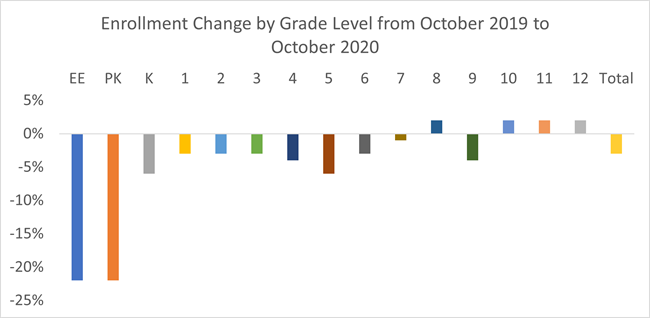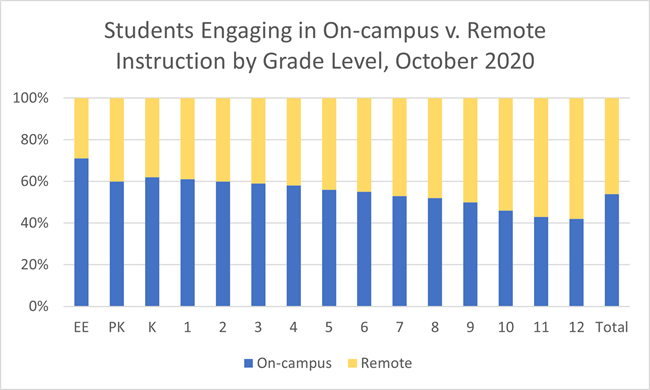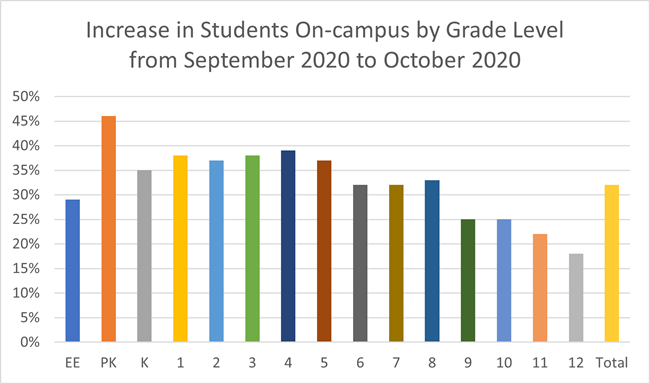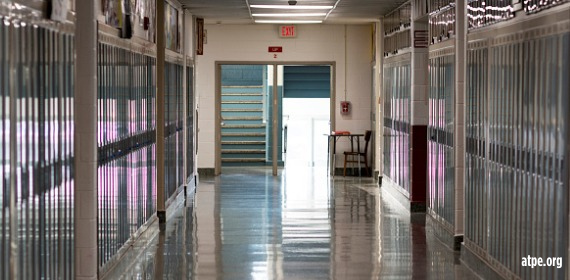TEA enrollment data show youngest Texas students aren’t in school

COVID-19 Curriculum | Instruction TEA | Commissioner | SBOE
Date Posted: 1/12/2021 | Author: Andrea Chevalier
Late last week, the Texas Education Agency (TEA) released data comparing Texas public school enrollment from October 2019 to October 2020, as well as data showing how many students were learning on-campus versus in a remote setting and how the number of students engaging in on-campus instruction had changed from September 2020 to October 2020.
Highlights:
- From October 2019 to October 2020, there was a 3% decline in enrollment, representing 156,596 students.
- Fifty-four percent of the decrease from October 2019 to October 2020 was in early childhood, pre-K, and kindergarten grade levels.
- A slight majority, 54% of students, were engaging in on-campus instruction in October 2020, with higher percentages of younger students accessing this option.
- From September to October 2020, the percentage of students on campus increased by 32% — an increase realized more so in grades lower than high school.
- Expect a new enrollment data release with demographics from TEA in late February.

TEA also shared the breakdown of how many students in each grade were on-campus and how many were remote in October 2020. Overall, 2,873,693 students (54%) were on-campus and 2,463,481 students (46%) were remote. We presume the number of students on-campus is higher now, given political pressures and TEA’s insistence and use of funding authority to influence the matter. While the actual number of students in early education is quite small relative to other grade levels (14,339), the proportion of early education students on-campus is the highest of any grade level. The percentage of students on-campus in each grade level steadily decreases as students get older. Again, this is no surprise, as older students can stay home without parents and self-regulate in their studies with greater ease than younger students.

Lastly, TEA compared the change in on-campus versus remote instructional settings between September 2020 and October 2020, noting a 32% increase (700,000 students) in those attending school on-campus over the period. The increase is apparent across all grade levels, most notably in pre-k and tapering off in the high school grades.

Enrollment likely looks much different in January 2021. The next update is expected to come late February and will be based off a January 29 data submission. To the satisfaction of those who looked at the October 2020 data and asked questions about demographic breakdown, the February report should include this additional information. TEA will release subsequent data in late April.
CONVERSATION
RECOMMENDED FOR YOU

Congress | Federal, COVID-19, Curriculum | Instruction, Educator Compensation | Benefits, Educator Preparation | Certification, Elections, School Finance, School Safety, Testing | Accountability, Texas Legislature
08/04/2023
Teach the Vote’s Week in Review: Aug. 4, 2023
ATPE weighs in on current political climate for education in Houston Chronicle story—plus, a look at federal ed prep and special education developments.

12/19/2025
Teach the Vote’s Week in Review: Dec. 19, 2025
Happy Holidays from ATPE! The ACLU of Texas is challenging SB 12 in federal court, and ATPE has distributed candidate surveys to those running for statewide, legislative, and SBOE seats.

12/18/2025
Gov. Abbott’s property tax promise and the split in the Texas GOP
Property taxes aren’t just a political talking point. They’re the main revenue source for vital local services, including police, fire, and public education.

